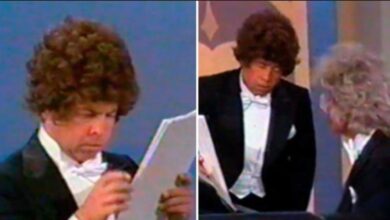The Ronettes’ “Be My Baby” Defines the Sound of 1963 and Echoes Through Generations
Released in the summer of 1963, “Be My Baby” by The Ronettes was more than just a pop single—it was a seismic shift in the landscape of popular music. Produced by Phil Spector and powered by the unmistakable voice of Ronnie Spector, the song soared to No. 2 on the Billboard Hot 100 and became a defining track of the girl group era. With its rich orchestration, emotional urgency, and instantly recognizable drumbeat, it didn’t just dominate charts—it reshaped what pop music could sound like.
The Ronettes, made up of lead singer Veronica “Ronnie” Bennett, her sister Estelle Bennett, and their cousin Nedra Talley, had their roots in Spanish Harlem. While several girl groups emerged in the early 1960s, The Ronettes stood out not only for their glamorous beehive hairdos and dramatic eyeliner but for their unique vocal style. Ronnie’s voice was sultry and raw, filled with longing and vulnerability that pierced through the wall of sound surrounding her.
“Be My Baby” was written by the trio of Ellie Greenwich, Jeff Barry, and Phil Spector—songwriting royalty of the Brill Building era. Inspired by teenage devotion and the thrill of new love, the lyrics were simple but potent: “So won’t you please / Be my little baby.” There was something timeless about its plea—a universality that allowed listeners of all backgrounds to connect with it. Spector envisioned a sound that would match the emotional weight of the words, and what followed was one of the most innovative recordings of the era.
Phil Spector’s “Wall of Sound” production technique reached its zenith with this song. The recording took place at Gold Star Studios in Los Angeles, where Spector employed a massive ensemble of musicians—The Wrecking Crew—to create a lush, layered arrangement. The now-iconic drum intro by Hal Blaine, featuring a thunderous “boom-BOOM-boom-CLAP,” served as the heartbeat of the track. Strings, brass, percussion, and backing vocals swelled around Ronnie’s voice, creating a cinematic experience unlike anything radio had played before.
The reception was immediate and intense. “Be My Baby” climbed rapidly up the charts and cemented The Ronettes’ place in pop royalty. It became the group’s highest-charting hit and one of the biggest singles of 1963. Critics hailed the song for its production brilliance and emotional intensity, while fans were swept away by its romantic urgency. Across both AM radio and jukeboxes in diners across America, the track became ubiquitous.
Culturally, the song captured the spirit of youth in the early ’60s: a generation caught between post-war innocence and the coming social revolutions. Its grand sound hinted at something deeper stirring beneath the surface—perhaps a yearning for escape, a promise of emotional grandeur, or simply the magic of falling in love. For young listeners, “Be My Baby” was both an anthem and a fantasy.
For The Ronettes, the song became a career-defining moment. Though they would release several other hits, including “Baby, I Love You” and “Walking in the Rain,” it was “Be My Baby” that ensured their immortality. The single led to national tours, appearances on television programs like American Bandstand, and opening slots for The Beatles during their 1966 U.S. tour. Ronnie Spector became a pop icon, her voice instantly identifiable and forever linked to this towering achievement.
The track’s impact extended beyond The Ronettes’ own catalog. It became a blueprint for artists seeking to marry emotional resonance with grandiose production. Brian Wilson of The Beach Boys was famously obsessed with the song, calling it the greatest pop record ever made. He even attempted to recreate its essence in his own work, particularly on “Don’t Worry Baby,” which was a direct homage to Spector’s masterpiece.
“Be My Baby” has been covered and referenced by countless artists. John Lennon and Bruce Springsteen cited it as a key influence. In the 1987 film Dirty Dancing, the song played during the opening credits, introducing it to a new generation and reviving its popularity. Amy Winehouse and Lana Del Rey both channeled elements of its style in their own music, nodding to Ronnie Spector’s legacy as a blueprint for soulful vulnerability.
The period surrounding its release was both thrilling and turbulent for The Ronettes. Their sudden fame brought both opportunity and tension, particularly due to Ronnie’s relationship with Phil Spector. Though they married in 1968, their relationship was marred by control and isolation. Years later, Ronnie would recount the darker side of her life during this time, contrasting the freedom of her voice with the limitations placed on her behind the scenes.
Still, the song’s legacy remains untarnished. Decades after its release, it continues to earn accolades. It was inducted into the Grammy Hall of Fame, and Rolling Stone placed it high on its list of the greatest songs of all time. That unforgettable drum intro remains one of the most sampled and referenced in music history, and the track itself still gets regular play on oldies stations and streaming platforms alike.
The influence of “Be My Baby” ripples through modern pop. Its emotional vulnerability, combined with sonic maximalism, has been emulated by producers across genres. The song helped lay the groundwork for Phil Spector’s production empire, but it also served as a cautionary tale about the tension between artistry and control in the music industry.
After Ronnie Spector’s passing in 2022, tributes poured in from every corner of the music world. Many included clips of her singing this song, her voice forever young, forever urgent. Artists and fans alike acknowledged that her legacy began and ended with those haunting, hopeful lines she first sang as a teenager.
In the grand story of American music, “Be My Baby” isn’t just a hit single—it’s a cornerstone. It defines an era, showcases a unique artistic vision, and continues to resonate across decades. For The Ronettes, and for Ronnie in particular, it wasn’t just a recording—it was a declaration. One that, sixty years later, still echoes with as much passion and promise as it did the first time it graced the airwaves.





